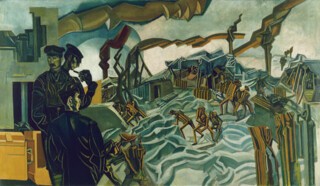In a 1932 article for the Daily Herald entitled ‘What It Feels Like to Be an Enemy’, Wyndham Lewis described his morning routine. After a breakfast of ‘a little raw meat, a couple of blood oranges, a stick of ginger, and a shot of vodka – to make one see Red’, he wrote:
I make a habit of springing up from the breakfast table and going over in a rush to the telephone book. This I open quite at chance, and ring up the first number upon which my eye has lighted. When I am put through, I violently abuse for five minutes the man, or woman of course (there is no romantic nonsense about the sex of people with an Enemy worth his salt), who answers the call. This gets you into the proper mood for the day.
Lewis made an art of antagonism. His default position – on matters social, political and aesthetic – was to be against things. He was against Bloomsbury, against Impressionism, against Virginia Woolf’s ‘interior method’, Henri Bergson’s ‘time cult’ and Gertrude’s ‘Stein stutter’. As a writer Lewis considered himself a satirist, and he intended some of his paintings to be satires too. Like the stories he told about himself, it’s difficult to work out which ones you’re meant to take seriously.
His public reputation has never really recovered from the polemics he wrote in the 1930s: a broadly sympathetic portrait of Hitler published in 1931 and a satirical take on anti-Semitism with the title The Jews: Are They Human? in 1939. Though he repudiated the central arguments in Hitler (chiefly, that the Führer was a man of peace: a ‘celibate inhabitant of a modest Alpine chalet – vegetarian, non-smoking and non-drinking’) in 1937, by then the damage had been done. Every now and then people try to rehabilitate him. The latest attempt – one of the most comprehensive – is the exhibition Life, Art, War at Imperial War Museum North (until 1 January 2018). Its vaguely Vorticist building, which sits beside the Manchester Ship Canal in Trafford, seems like an appropriate setting.
Lewis is best known nowadays as the blaster and bombardier of the Vorticist years, but it is clear from this exhibition – which consists mainly of his own paintings and drawings arranged in chronological sequence – that over the course of his career he tried on and discarded styles with the seasons. The earliest pictures are sketches from his time as a student at the Slade, where he studied under Henry Tonks, befriended Augustus John and was chucked out after a few months for poor attendance; they show him to be a talented and restrained draughtsman. Eight years later, having flirted with the idea of becoming a poet, he turned to primitivism: Anthony (1909) is a monolithic head on a yellow background that has something of the savagery of the faces he would later paint; The Theatre Manager (1909), a Léger-like watercolour, was produced when he was loosely associated with the Camden Town Group (they hated it).
In 1912 he tried his hand at Cubism with Smiling Woman Ascending a Stair, a sinister, angular portrait of the painter Kate Lechmere, who funded his short-lived Rebel Art Centre. It’s a painting that shows how Lewis could turn human bodies into cold mechanical objects without reducing them, in the manner of the Futurists, to mere machines. ‘You wops insist too much on the machine,’ he told F.T. Marinetti when they met in a toilet in London in 1914. ‘You’re always on about these driving belts, you’re always exploding about internal combustion. We’ve had machines here in England for donkey’s years. They’re no novelty to us.’ After a period spent painting decorative doodles for Roger Fry’s Omega Workshop (until they fell out over a commission from the Daily Mail to do up a room for the Ideal Home Exhibition in a Futurist manner), Lewis decided that the best way to get on was to invent – or at least brand – a movement all of his own.
Vorticism announced itself in the first issue of Lewis’s magazine Blast in July 1914, in which he called for ‘a new living abstraction’ to stand against the ‘sentimental future’ and the ‘sacripant past’. Part of the appeal of Vorticism, which the exhibition’s curators describe as ‘Britain’s only true avant-garde movement’, was that Lewis gave such good copy, but it now looks like an incoherent mishmash of aesthetic posturing and soundbites, united under Ezra Pound’s phrase ‘the Great English Vortex’. On the evidence here it was the least interesting thing that Lewis ever did. His paintings and drawings from these years are either muddy and timid and aimlessly decorative, or argumentative and biting in ways that now seem obscure. The most successful Vorticist work in the show is Henri Gaudier-Brezska’s playful animal sculpture Bird Swallowing a Fish, made in plaster a year before his death and only cast, by Henry Moore, in the 1960s.
Maybe the problem was that like the manifestos he churned out in the 1910s, Lewis’s Vorticist works were more interested in having arguments than in being interesting themselves. The Domino (1912) could be read as an attempt to subvert Matisse’s romantic primitivism (which Lewis also satirises in his short story collection The Wild Body) by clothing it in Vorticist garb, or it could be a fairly dull picture of two people next to a chair. Sunset among the Michelangelos (1912) was supposed to be a manifesto in paint, but instead it shows how unsuited abstraction is to Lewis’s brand of visual polemicism. Human figures like deflated Michelin men sit on a pile of rocks, heralding the decline of the kind of art Lewis was taught to make at the beginning of his career. You can’t help but feel the intended targets of his scorn might not have noticed.
‘Avant-garde in itself,’ Lewis wrote in his autobiography Rude Assignment, ‘is not a merit or a demerit. Some people are the changers and some the conservers.’ He thought of himself as a changer, but in many ways he was a better conserver. His best work was done in response to individual people and specific situations, rather than in the service of -isms and -ologies, and when the First World War broke out he found his most important subject. He joined the Royal Artillery in January 1916 (a bad bout of chlamydia prevented him volunteering before this), after petitioning for a commission by claiming to possess an exceptional ‘organising capacity’, having ‘organised the “Cubist” invasion of England without the loss of a single Cube!’ At first he worked as a gunner observer, spotting and marking out targets, but before long he was recruited by the critic P.G. Konody to produce a painting for the Canadian War Memorials Fund. Another commission, this time for the British, soon followed.
Life, Art, War may be the Imperial War Museum’s attempt to make amends for the fact that Lewis’s war commissions were suppressed for so long: neither A Canadian Gun-Pit (1918) nor A Battery Shelled (1919), both extraordinary paintings, were popular with the bodies which commissioned them. Konody had told him to rein in the Vorticism, but Lewis couldn’t resist adding a few ape-like, lurching automata in the background: versions of Jacob Epstein’s Rock Drill figure, which had been exhibited in the first (and only) Vorticist exhibition in 1915. A Battery Shelled, in which three soldiers watch their comrades scuttling over a broken landscape, was deemed to be insufficiently respectful, and loaned to the Tate, where it was never shown. Lewis, too, was unhappy with the results of his war commissions, though for different reasons. ‘On looking at my Canadian painting today,’ he wrote to Herbert Read, ‘I came to the conclusion that Konody had succeeded in making me paint one of the dullest good pictures on earth. I have just done another painting in an afternoon which is at least 17 times as alive. What a nightmare this wicked war has been.’
In fact, the pictures are still shocking: war gave Lewis a subject which was equal to his anger. He pays as much attention to the angle of a rack of shells as he does to the bodies of the men around them. Unlike some of his peers, he wasn’t interested in the dynamism of war – there are no explosions, his war paintings are strangely static. Nor did the war do much to strip him of the schoolboyish contrarianism of Blast. But it did give him a way of applying Vorticism to the real world, providing a context for what Read called ‘the geometry of fear’. Lewis’s work can still feel more modernist than any of his peers’.
After the war he worked as a jobbing portraitist, and it is the paintings from this period – intimate, stylised but essentially realist, and made on spec in an increasingly desperate attempt to stay afloat – that show him at his best. He painted Edith Sitwell (before falling out with her when he realised she wasn’t as rich as her siblings) in a geometric green jacket and funny hat, and T.S. Eliot, brooding with hooded eyes, set against an abstract background. This proved too much for the Royal Academy, which rejected the portrait for its Summer Exhibition (much to Lewis’s pretend outrage). He painted the Scottish novelist Naomi Mitchison looking down at him with one eyebrow raised, as though gently mocking his radical pretentions. Lewis’s series of portraits of his second wife, Gladys Hoskyns, show the same attention he paid to machines and artillery in the war, attention that suggests he’d reconciled himself to living, and looking, from the outside.
Send Letters To:
The Editor
London Review of Books,
28 Little Russell Street
London, WC1A 2HN
letters@lrb.co.uk
Please include name, address, and a telephone number.


